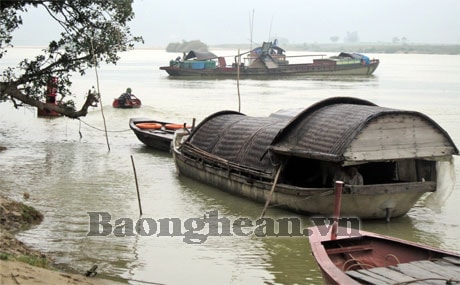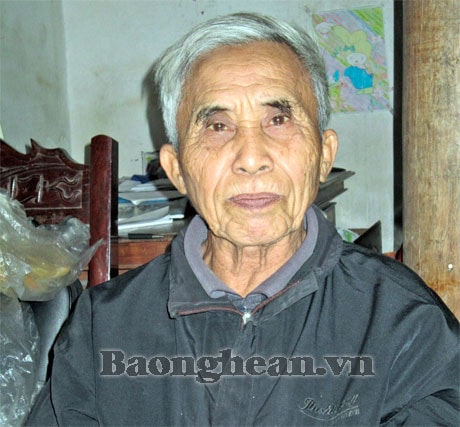Memories of Van Ru ferry
(Baonghean)During the confrontation with the US Air Force and Navy, Nam Dan District (Nghe An) was one of the 12 "death gates" on the fire line of Zone IV. This land had the vital road 15A running through it, located between two places that have become legends about the will, fighting spirit and sacrifice of our people: Truong Bon and Dong Loc Junction. At that time, Van Ru ferry, in Nam Dong Commune (now Khanh Son Commune) was also considered a "bomb bag"...

Peaceful scene at Van Ru ferry.
One day at the end of the year, we went to Khanh Son, visited Van Ru ferry, a place that became a legend during the American war in the hearts of Nam Dan people... The Lam River downstream seemed to flow slower, perhaps lingering with the Motherland before merging with the ocean? Below the river, fishing boats, passenger boats and sand and gravel mining boats were bustling back and forth. Along both banks, yellow mustard flowers bloomed on the riverbank, followed by lush green corn fields, vast rice fields, and bustling villages. In front was the green color and majestic appearance of the Thien Nhan range reflected in the gentle Lam River. Looking at that poetic, charming, rich and peaceful scene, few people knew that this place was once a bloody and fiery place, a "death gate" and contributed to writing the heroic and glorious history of the strategic route 15A.
Asking about the old stories, the time of bombs, the people at Van Ru ferry showed us the way to the house of Mr. Tong Xuan Hung - former Secretary of the Party Committee of Nam Dong commune, Chairman of the Fisheries Cooperative in the 60s - 70s of the last century. Following the instructions, we went up Highway 15A for a few kilometers, to find Hamlet 5, Khanh Son commune. About to turn 84, Mr. Hung is still healthy, active, and has a clear memory.
He remembers in detail each fierce bombing and the casualties at Van Ru ferry. "In this Khanh Son area, there is no place that has escaped the plowing of American bombs, missiles and rockets" - Mr. Hung began his reminiscence. Route 15A through Khanh Son commune is extremely dangerous, on one side is Thien Nhan mountain range, on the other side is Lam river. With the terrain of mountains and rivers, this place became a "bottleneck" in the journey to support human and material resources to the South. Determining the dangerous nature, American planes regularly dropped bombs, hoping to completely cut off the strategic route. Every day, this land had to endure many bombs from the enemy. Almost every day, the route through here was divided, local militiamen took turns day and night to fill bomb craters, but when they finished, American planes came to drop another round of bombs. Sometimes, before the leveling work was completed due to the previous series of bombs, the "thunder gods" came again, causing countless difficulties and dangers in fighting and production. In that situation, to avoid casualties and reduce damage, when marching to the present-day Nam Dan Town, our troops turned down the Ta Lam dike, to Xuan Lam commune, passing Van Ru ferry to continue the journey. But after a short time, the enemy discovered our troops' new direction of movement and continuously bombed the Van Ru ferry area. And another reason for the US Air Force to conduct "carpet bombing" in this area was that they discovered that in this section of the river we were constructing a system of communication lines and a pipeline to supply fuel to the southern battlefield.
Mr. Tong Xuan Hung
At that time, Mr. Tong Xuan Hung was the Party Secretary of the commune, Chairman of Dai Thanh Cooperative - the unit responsible for exploiting, catching and transporting fish on Lam River. "When the US escalated its air and naval attacks on the North, our Cooperative received orders to switch to wartime. That is, to put the task of transporting soldiers and weapons and equipment safely across the river to the top priority" - the former chairman recalled. The war was increasingly fierce, the needs of the battlefield were growing, so the tasks of the army and people of Nam Dong commune became heavier and heavier. At one point, the Cooperative had to mobilize more than 150 boats to transport soldiers across the river. At that time, 14-15 year old children were mobilized to row boats on the river, each family had 3-5 members participating and forming a team. Starting from 5 pm, when fog covered the Thien Nhan range and obscured the surface of Lam River, the boats of Dai Thanh Cooperative deployed into formation to carry out the task. By 6am the next morning, the sun was beginning to shine brightly, the commune members stopped transporting soldiers across the river and hid and camouflaged the boats to avoid enemy detection. Thus, every night, thousands of soldiers crossed the river safely.
"To ensure the safety of thousands of soldiers crossing the river, the people of Nam Dong commune did not fear difficulties and dangers. During that period, hundreds of people were killed and injured by enemy bombs..." - Mr. Tong Xuan Hung sadly recalled. Faced with increasingly fierce bombing by US aircraft and increasingly dense bombs and mines, Nam Dong commune decided to establish the "Steel" Company and the "10 Lam River Girls" Squad, ready to die. The mission of the "Steel" Company is to respond in emergency situations, coordinate with anti-aircraft artillery units to shoot down enemy aircraft, fill bomb craters, clear bombs and mines, protect the communication line system, oil and gas pipelines and transport officers and soldiers across the river in urgent cases. The "10 Lam River Girls" Squad is responsible for camouflaging boats, weapons and vehicles of the army and participating in rescue in case of casualties.
Mr. Hung said: "During the war, countless American bombs were dropped on this land. Blockbuster bombs, cluster bombs, magnetic bombs, missiles and rockets... But the most frightening are still magnetic bombs, because if you are careless or not paying attention, casualties can happen at any time." As the leader of the "Steel" Company, he has been a pioneer in mine clearance many times. After each bombing, he and a few teammates rowed a boat on the river, pulling a long fishing line, at the end of which was tied an iron object to detonate the magnetic bombs lying on the riverbed. Once, a bomb exploded at close range, causing a huge shock that caused his boat to capsize in the middle of the river. Fortunately, everyone was a "son of a thousand", with a lot of experience on the river, so they were still strong enough to swim to shore. Another time, a time bomb fell at the foot of Ru Tret next to Van Ru ferry. No one dared to go near this area, let alone defuse the bomb.
As Party Secretary, Cooperative Chairman, and leader of the "Steel" Company, Mr. Tong Xuan Hung decided to volunteer to go to Ru Tret to destroy the bomb. Despite his old mother's dissuasion, Mr. Hung still went to the garden to cut down the oldest and hardest bamboo tree, carved it into a shovel to dig the ground to find the bomb. After nearly an hour of digging, he finally found the location of the bomb and used explosives to detonate it. After the earth-shattering explosion, he returned home to see many people gathered in the house and in the yard, many of whom were crying bitterly. "Because at that time, everyone thought that destroying a bomb meant going and not coming back" - Mr. Hung confided. Currently, the leader of the "Steel" Company still keeps a notebook recording the fierce bombings and the great casualties of the people of Nam Dong. Reading the notebook, we can truly feel the fierce nature and the dangers and losses that the people here often faced during the days of living and fighting under the rain of bombs and bullets. According to Mr. Hung's notes, on June 10, 1968, a convoy of vehicles carrying wounded soldiers from the battlefield was discovered by the enemy and planes dropped bombs, killing 23 people, not to mention dozens of others injured. On July 25, 1968, a group of planes dropped 3 cluster bombs, killing 16 people and injuring 96. On September 4 (lunar calendar) of 1968, more than 10 B-52s came to drop bombs, killing 26 people and injuring 97 others...
Following Mr. Hung's instructions, we went up Route 15A to Lam Son - Nam Dan Town to meet members of the former "Steel" Company. Mrs. Pham Thi Hop (80 years old) recounted: "There was a time when we rowed a boat to carry soldiers across the river every night. One time, the enemy dropped flares that were as clear as day, then a series of bombs were dropped. I clearly saw two mother bombs and hundreds of baby bombs falling on Ru Tret, only a very short distance from the boat." Mrs. Nguyen Thi Duong (85 years old) said: "Sometimes, I just rowed the boat across, just stepped ashore, and right at that moment a series of bombs fell. At that time, it was all thanks to luck. Until now, in my dreams I still often see the scene of falling bombs and exploding bullets of those fierce years." Asked about the 10 Lam River girls of the past, after a moment of searching his memory, Mr. Tong Xuan Hung sadly replied: "After the war, each of them went their separate ways. Some married far away, some went to work, some followed their children and grandchildren to live elsewhere... It's very difficult to meet them again now!"
Returning to the Van Ru ferry, the former Chairman of Dai Thanh Cooperative recalled with emotion the days of bombs and bullets. In his memory, every plot of land, road, river section and rock outcrop contained traces of war. His younger brother's house was located at the foot of Ru Tret, below which there was an unexploded bomb. Following the riverbank upstream, a villager was injured or killed while cutting grass and stepped on a magnetic bomb left over from the war decades ago. In the middle of the river, more than ten years ago, someone who was raking mussels also picked up cluster bombs, and occasionally still found bombs deep in the ground. "This land still contains many dangers due to traces left by the enemy" - Mr. Hung mused.
After a moment of contemplation at Van Ru ferry, Mr. Tong Xuan Hung suddenly said: "This place was once glorious, if only there were a stele, a shrine to commemorate and honor those who fell on this land so that future generations would always remember. At the same time, reminding that underground, in the middle of the river, there are still many hidden dangers..."!
Cong Kien
